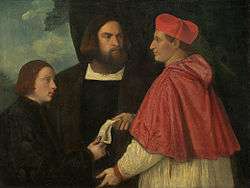Marco Cornaro (cardinal)
Marco Cornaro (1482 – 24 July 1524) (called Cardinal Cornaro and Cardinal Cornelius) was an Italian Roman Catholic cardinal and bishop.

Biography
A member of the House of Cornaro, Marco Cornaro was born in Venice in 1482, the son of Giorgio Cornaro and Elisabetta Morosini.[1] He was the nephew of Catherine Cornaro, Queen of Cyprus.[1] He was ordained a priest by Pope Clement VII.[2] His older brother Francesco Cornaro was also a cardinal.[1] Early in his life, Marco Cornaro was a protonotary apostolic.[1]
Pope Alexander VI made Cornaro a cardinal deacon in the consistory of 28 September 1500.[1] He received the deaconry of Santa Maria in Campitelli on 5 October 1500.[1]
He arrived in Rome on 1 September 1503 and then participated in both the papal conclave of September 1503 that elected Pope Pius III, and the papal conclave of October 1503 that elected Pope Julius II.[1]
On 29 November 1503 he became apostolic administrator of the see of Verona, occupying this post to his death.[1] He was elected Bishop of Famagusta on 11 December 1503; he resigned this see on 1 July 1504.[1] In July 1506, he was named titular Latin Patriarch of Constantinople, holding this see until 30 October 1507, and then again from 11 June 1521 until his death.[1] In January 1511, he accompanied Pope Julius II during the siege of Mirandola.[1] The pope then named him papal legate to the Patrimonium Sancti Petri, holding this position until 1514.[1] He was also involved in the negotiations to reconcile the Republic of Venice with Pope Julius II.[1]
He participated in the papal conclave of 1513 that elected Pope Leo X.[1] On 19 March 1513 he opted for the deaconry of Santa Maria in Via Lata.[1]
During the Fifth Council of the Lateran, he served on the Commission of Reform.[1]
He became a canon of Treviso Cathedral on 23 April 1513.[1] On 11 December 1513 he beame chancellor of the metropolitan see of Nicosia.[1] On 4 April 1514, he was elected Bishop of Nemosia; he resigned this see on 22 March 1516.[1] On 9 March 1517 he became Bishop of Padua, occupying that see until his death.[1] On 4 November 1517 he became a member of the commission of cardinals on war with the Ottoman Empire.[1] He became administrator of the see of Nardò and legate to the Patrimonium Sancti Petri on 24 January 1519, holding this office until 20 February 1521.[1]
He became cardinal protodeacon on 20 December 1520.[1] He participated in the papal conclave of 1521–22 that elected Pope Adrian VI.[1] As cardinal protodeacon, he announced Adrian VI's election to the people of Rome on 9 January 1522 and crowned the pope in the papal coronation held in St. Peter's Basilica on 31 January 1522.[1]
He participated in the papal conclave of 1523 that elected Pope Clement VII.[1] As cardinal protodeacon, he crowned the new pope on 26 November 1523.[1] Cardinal Cornaro was one of three cardinals whom the new pope named to inquire about the Lutherans.[1]
On 14 December 1523 he opted for the order of cardinal priests and the titular church of San Marco.[1] On 20 May 1524 he opted for the order of cardinal bishops and the Suburbicarian Diocese of Albano.[1] He opted for the Suburbicarian Diocese of Palestrina on 15 June 1524.[1]
He died in Venice on 24 July 1524.[1] He was initially buried in the Church of San Giorgio Maggiore.[1] In 1570, his remains, along with those of the other cardinals of his family, were transferred to St Mark's Basilica.[1]
References
- Miranda, Salvador. "CORNARO, Marco (1482-1524)". The Cardinals of the Holy Roman Church. Florida International University. OCLC 53276621.
- Cheney, David M. "Marco Cardinal Cornaro". Catholic-Hierarchy.org. Retrieved February 14, 2019. [self-published]
| Catholic Church titles | ||
|---|---|---|
| Preceded by Giovanni Battista Zeno |
Cardinal-Deacon of Santa Maria in Portico 1500–1513 |
Succeeded by Bernardo Dovizi da Bibbiena |
| Preceded by Giovanni Michiel |
Administrator of Verona 1503–1524 |
Succeeded by Giovanni Matteo Giberti |
| Preceded by Alvise Cippico |
Bishop of Famagusta 1503–1504 |
Succeeded by Mattia Ugoni |
| Preceded by Francisco Lloris y de Borja |
Titular Patriarch of Constantinople 1506–1507 (1st term) |
Succeeded by Tamás Bakócz |
| Preceded by Pedro Luis de Borja Lanzol de Romaní |
Cardinal-Deacon of Santa Maria in Via Lata 1513–1523 |
Succeeded by Alessandro Cesarini (seniore) |
| Preceded by Nicola Dolci |
Bishop of Nemosia 1514–1516 |
Succeeded by Paul Borgasius |
| Preceded by Sisto Gara della Rovere |
Bishop of Padua 1517–1524 |
Succeeded by Francesco Pisani |
| Preceded by Luigi d'Aragona |
Administrator of Nardò 1519–1521 |
Succeeded by Giacomo Antonio Acquaviva |
| Preceded by Franciotto Orsini |
Archpriest of the Basilica di San Pietro in Vaticano 1520–1524 |
Succeeded by Francesco Cornaro (seniore) |
| Preceded by Tamás Bakócz |
Titular Patriarch of Constantinople 1521–1524 (2nd term) |
Succeeded by Egidio da Viterbo |
| Preceded by Domenico Grimani |
Cardinal-Priest of San Marco 1523 |
Succeeded by Francesco Pisani |
| Preceded by Pietro de Accolti de Aretio |
Cardinal-Bishop of Albano 1524 |
Succeeded by Lorenzo Pucci |
| Preceded by Pietro de Accolti de Aretio |
Cardinal-Bishop of Palestrina 1524 |
Succeeded by Lorenzo Pucci |